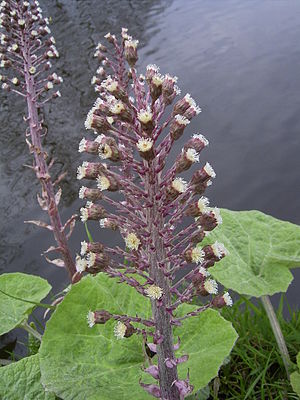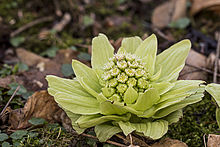Common butterbur
| Common butterbur | ||||||||||||
|---|---|---|---|---|---|---|---|---|---|---|---|---|

Common butterbur ( Petasites hybridus ) |
||||||||||||
| Systematics | ||||||||||||
|
||||||||||||
| Scientific name | ||||||||||||
| Petasites hybridus | ||||||||||||
| ( L. ) Gaertn. |
The common butterbur ( Petasites hybridus (L.) G. Gaertn., B.Mey. & Scherb. , Syn .: Petasites officinalis Moench ), also called Bach butterbur or red butterbur , is a species of the sunflower family (Asteraceae ).
description
The perennial herbaceous plant reaches heights of growth between 10 and 40 centimeters at flowering time and up to 120 centimeters at fruiting time. The rhizome is about 4 cm thick, brownish and thickened at the limb ends. The round leaves can spread up to 60 cm in diameter. The lowest lateral nerves run along the edge of the peduncle and limit it. The underside of the leaves is gray and woolly, later balding. The leaf stems are hollow on the inside and clearly grooved on the sides.
The inflorescences appear between March and May before the basal leaves . The compound, racemose inflorescence has numerous, densely packed reddish-white to red-purple flower heads (partial inflorescences ). The male flower heads are about 7 to 12 mm long and about twice as large as the female.
The chromosome number of the species is 2n = 60.
Occurrence
The species prefers oozing wet or temporarily flooded, nutrient-rich soils and is therefore often found on stream and river banks. In Central Europe it is a character species of the Phalarido-Petasitetum hybridi from the association of the Aegopodion podagrariae.
The distribution area includes Europe north to Scotland , Turkey and the Caucasus. It is a neophyte in Denmark, Norway, Sweden, the Baltic States and the US state of Michigan.
In the Allgäu Alps, it rises in Hochkrumbach in Vorarlberg up to 1720 m above sea level.
biology
The common butterbur is important as an alluvial paver. A certain level of humidity is required for optimal development. It is one of the first spring flowers and is pollinated by bees. The cylindrical, hairy fruits are spread by the wind.
Taxonomy
The common butterbur ( Petasites hybridus (L.) G. Gaertn., B.Mey. & Scherb. ) Has the synonyms Tussilago hybrida L. , Petasites georgicus Manden. , Petasites officinalis Moench nom. illeg., Petasites ovatus Hill nom. nov., Petasites pratensis Jord. , Petasites vulgaris Desf. nom. illeg., Tussilago petasites L.
use
Historical use
The Greeks and Romans valued butterbur against malignant ulcers in the 1st century just like the people of the Middle Ages who used it against the plague . In folk medicine , various preparations of the plant are also used as an expectorant cough suppressant and as a coolant for insect bites. In the 19th century the spasmolytic and analgesic effects were recognized for the first time and the plant and its preparations were rediscovered for medical use.
Modern use

You are warned against making tea from butterbur leaves or roots, because in its natural state the plant contains substances ( pyrrolizidine alkaloids ) with mutagenic, carcinogenic and possibly toxic effects on the liver. For standardized finished preparations, however, only plants from controlled cultivation of a low-pyrrolizidine alkaloid chemo variety (see below) are used; In addition, residual amounts of pyrrolizidine alkaloid are largely removed using special extraction processes. Today butterbur extracts are used in various phytopharmaceuticals, whereby the spasmolytic effect on the smooth muscles is in the foreground. For this, extracts from the rhizome are preferably used. They are indicated e.g. B. with spasms of the gastrointestinal tract and cramp-like complaints in the area of the lower urinary tract. In addition, butterbur preparations are z. B. used in migraine prophylaxis . A possible effectiveness in primary dysmenorrhea or improved ventilation in bronchial asthma was also determined. A standardized CO 2 extract (Ze 339) from the leaves is used as an antiallergic agent; its effectiveness has been proven by scientific studies. In Germany, there has been no butterbur product on the market since 2009, after the approval for the Petadolex product expired.
It has been known since the 1960s that Petasites hybridus exists in two chemo varieties. One (furanopetasin variety) contains so-called furanoeremophilans and eremophilan lactones, which cannot be found in the plants of the other type. This other (Petasin) variety contains, for example, Petasin, Neopetasin and Isopetasin. The latter may only arise during storage. There also appears to be a mixed variety containing petasins and furanopetasins.
The ingredients known as pyrrolizidine alkaloids (PA) are ester alkaloids, the basic structure of which is necin. Substances are considered toxic if there is a double bond between positions 1 and 2 in the necin structure . In the liver , these substances are converted into pyrroles, which can bind to DNA and RNA and thus impair protein synthesis and cell division . This leads to metabolic disorders and liver tissue damage. Pyrrolizidine alkaloids are removed from extracts for the production of phytopharmaceuticals.
In Japan, at the beginning of spring in April, young plants of the Asian butterbur ( Petasites japonicus ) that are just emerging from the ground are collected. They are fried and eaten as tempura. They have a slightly bitter taste and are called “Fukino tou” in Japanese.
literature
- HE Hess, E. Landolt, R. Hirzel: Flora of Switzerland and adjacent areas . Birkhäuser Verlag Basel, 1972.
- B. Meier, M. Meier-Liebi: Monograph Petasites in Hager's Handbook of Pharmaceutical Practice . 5th edition. Springer Verlag, 1995
- K. Bucher: About an antispastic principle in Petasites officinalis Moench . Naunyn-Schmiedeberg's Archives of Pharmacology 213, 1951, pp. 69-71, doi : 10.1007 / BF02432740 , ISSN 0028-1298
- M. Neuenschwander, A. Neuenschwander, E. Steinegger: Structure of the sesquiterpenes of Petasites hybridus: Neopetasol derivatives . Helvetica Chimica Acta 62, 1979, pp. 627-634, ISSN 0018-019X
- B. Meier, A. Hasler: Commercial drug and petasin content in butterbur - state of research . Zeitschrift für Phytotherapie 15, 1994, pp. 268-284, ISSN 0722-348X
- O. Thomet: Effectiveness of butterbur extract Ze 339 in allergic rhinitis . phytotherapy 3, 2002, pp. 10-13
- Bühring, Ursel : practical textbook of modern medicinal herbalism. Basics - application - therapy. Sonntag Verlag, Stuttgart 2005
Individual evidence
- ↑ a b Erich Oberdorfer : Plant-sociological excursion flora for Germany and neighboring areas . 8th edition. Stuttgart, Verlag Eugen Ulmer, 2001. Page 947. ISBN 3-8001-3131-5
- ^ A b Petasites in the Germplasm Resources Information Network (GRIN), USDA , ARS , National Genetic Resources Program. National Germplasm Resources Laboratory, Beltsville, Maryland. Retrieved March 8, 2018.
- ↑ Erhard Dörr, Wolfgang Lippert : Flora of the Allgäu and its surroundings. Volume 2, IHW, Eching 2004, ISBN 3-930167-61-1 , p. 613.
Web links
- Common butterbur. In: FloraWeb.de.
- Common butterbur . In: BiolFlor, the database of biological-ecological characteristics of the flora of Germany.
- Profile and distribution map for Bavaria . In: Botanical Information Hub of Bavaria .
- Petasites hybridus (L.) P. Gaertn. & al. In: Info Flora , the national data and information center for Swiss flora . Retrieved May 16, 2016.
- Distribution in the northern hemisphere according to Hultén
- Thomas Meyer: Butterbur data sheet with identification key and photos at Flora-de: Flora von Deutschland (old name of the website: Flowers in Swabia )
- Use in folk medicine









